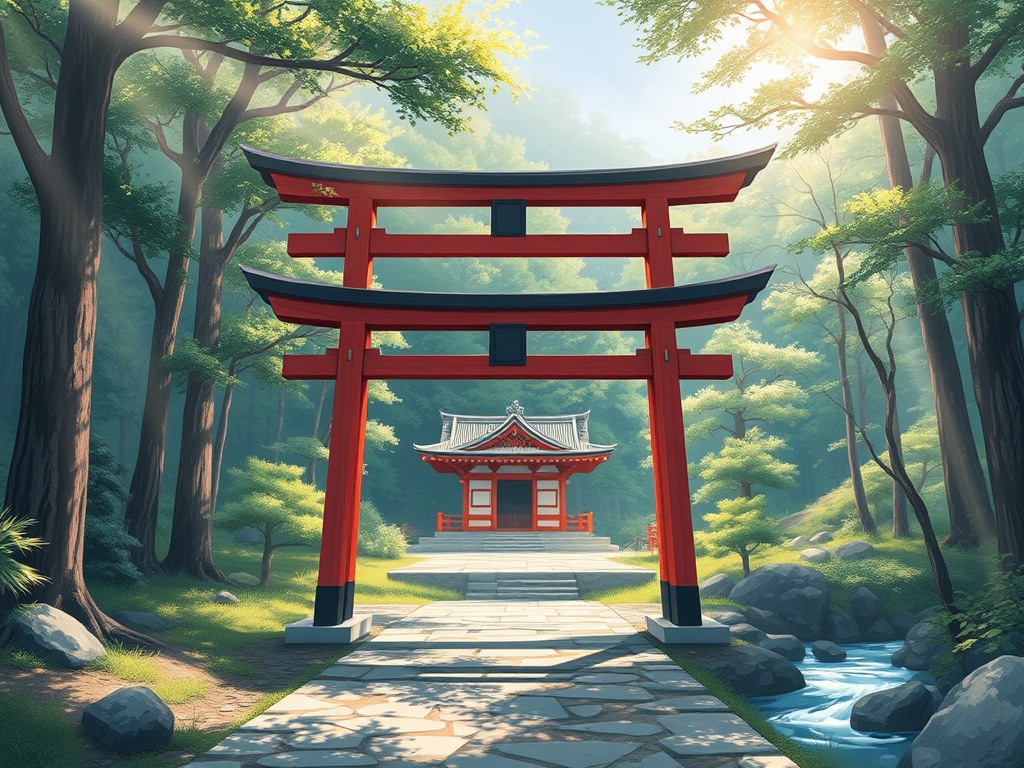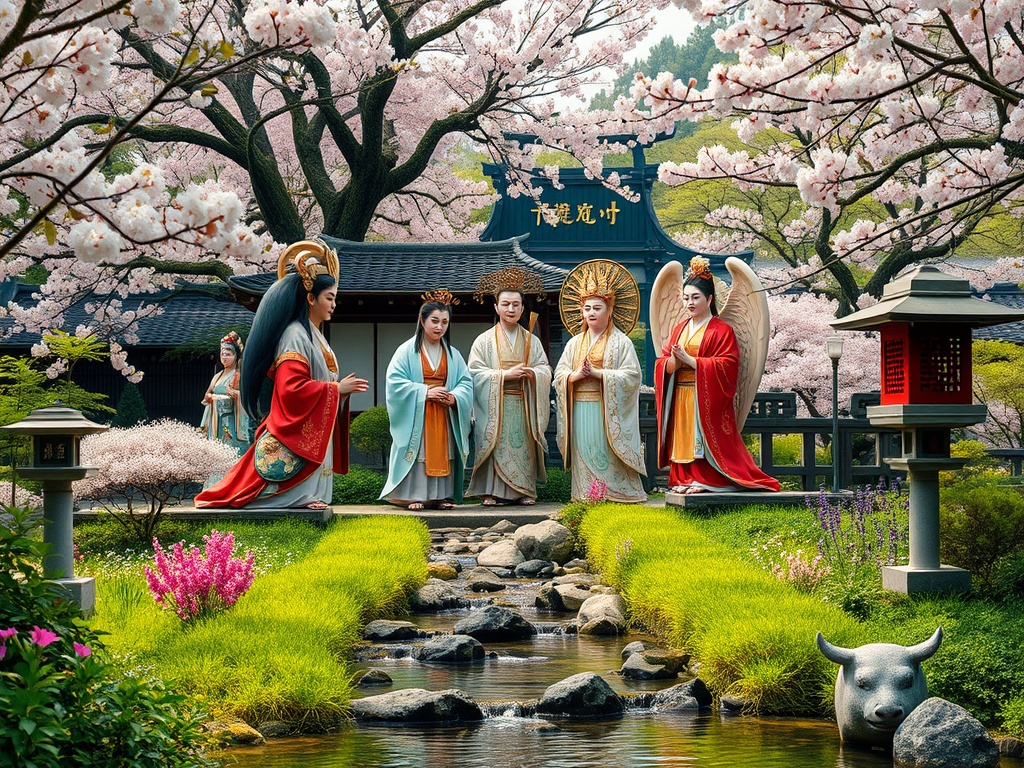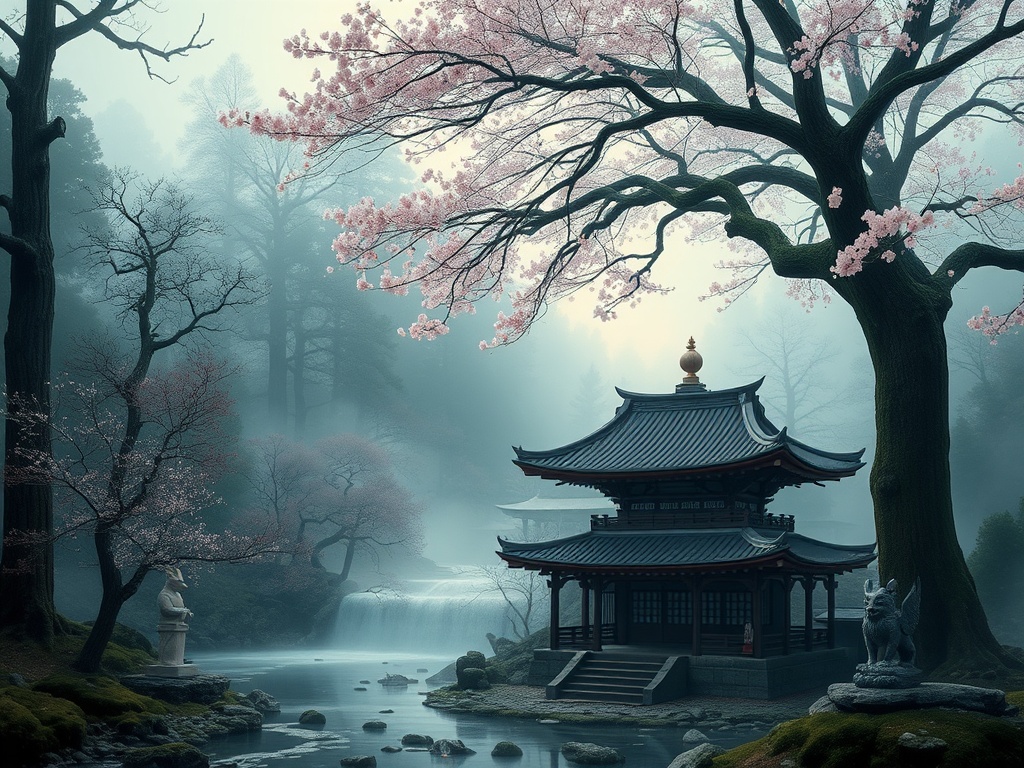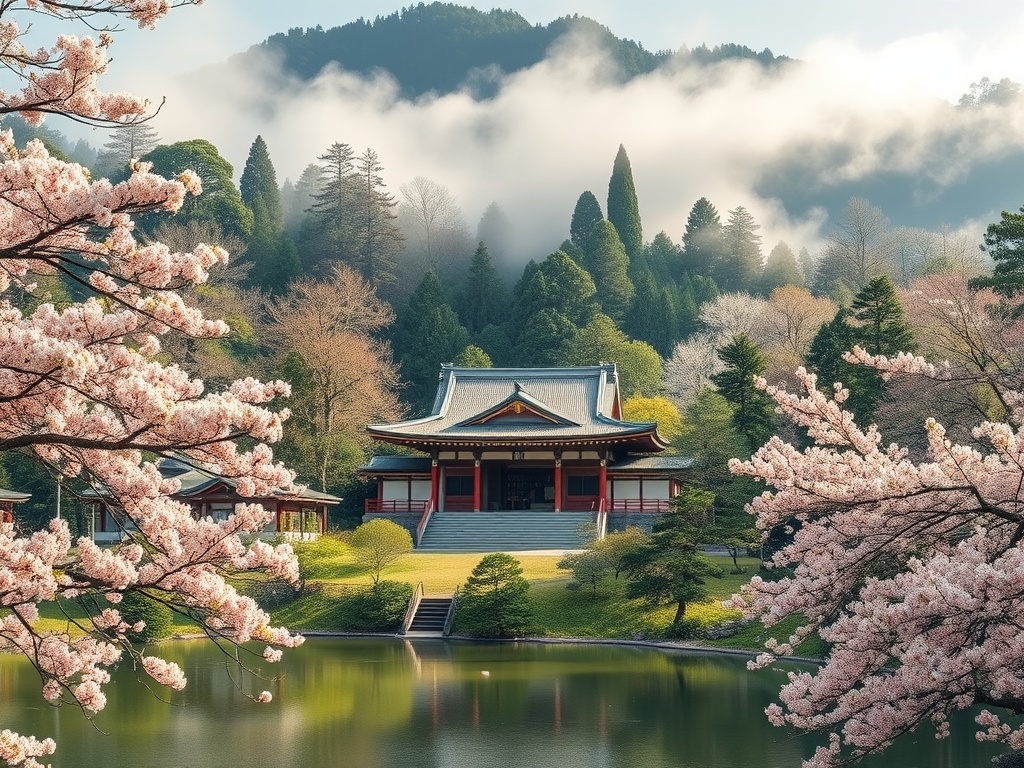Unveiling the Pantheon: Meet the Fascinating Deities of Shinto
Win a Free Trip to Japan!
Experience cherry blossoms and ancient temples
Dive into the mystical world of Shinto, Japan’s indigenous spirituality, where gods and spirits reside in every element of nature, from the towering mountains to the whispering winds. Shinto, literally meaning ‘the way of the gods’, offers a unique spiritual landscape, intertwining myth, ritual, and nature worship. As a traveler, understanding this vibrant pantheon can deepen your appreciation of Japan’s rich cultural tapestry.
In Shinto, the gods are known as kami, a term that encompasses a wide range of spiritual beings and forces. These deities embody elements of nature, ancestors, and even historical figures. Their stories are deeply rooted in the landscapes and history of Japan, making each shrine visit a journey through myth and time.
Fascinating Kami to Discover:
- Amaterasu: The sun goddess, who is considered the most revered kami, is believed to be the ancestor of the Imperial family. Her main shrine is the Ise Grand Shrine, a must-visit for those interested in imperial history and spirituality.
- Susanoo: The storm god, known for his wild and unpredictable nature. His adventures include slaying a fearsome serpent, echoing tales of heroism that are celebrated in various Shinto festivals.
- Inari: The god of rice and prosperity, often represented by foxes. Inari shrines, like the famous Fushimi Inari-taisha in Kyoto, are distinctive with their striking red torii gates.
Shinto practices are not confined to spiritual rituals alone; they are vibrant, communal celebrations that invite everyone to partake in the divine. From awe-inspiring festivals to serene shrine ceremonies, these experiences offer a glimpse into the sacred.
Must-Experience Shinto Festivals:
- Gion Matsuri: Held in Kyoto, this grand festival dates back over a thousand years and is renowned for its elaborate floats and street processions.
- Shogatsu: The Japanese New Year celebration, where people visit shrines to pray for prosperity and health, is a perfect time to witness Shinto traditions in action.
Land of Myths: Exploring the Ancient Origins of Japanese Folklore
Embark on a journey through the enchanting Land of Myths, where every tale is steeped in the essence of Japan’s cultural and spiritual history. This ancient folklore is not merely a collection of stories; it is a vibrant tapestry woven with the threads of the nation’s identity. As you explore these myths, you will uncover the heart and soul of Japan, a place where legends leap to life amidst the serene landscapes and bustling festivals.
At the heart of Japanese mythology lie creation myths that explain the origins of the islands and their divine inhabitants. According to legend, the islands of Japan were formed when the deities Izanagi and Izanami, the celestial siblings, were tasked with creating land. Using a jeweled spear, they stirred the ocean, and as the drops fell back into the sea, they formed the islands we know today. This divine act set the stage for the rich tapestry of gods and spirits that would come to inhabit these lands.
As you delve deeper into the folklore, you will encounter the yokai – supernatural creatures that embody the mysterious and often mischievous aspects of nature. Unlike the kami, yokai range from benevolent protectors to fearsome apparitions, each with its own story to tell. Whether it’s the shape-shifting kitsune or the playful tanuki, these spirits invite travelers to look beyond the surface and embrace the mysteries that lie within the natural world.
- Kitsune: Fox spirits known for their intelligence and magical abilities, often associated with the god Inari.
- Tengu: Bird-like creatures, both revered and feared, believed to be guardians of the mountains and skilled in martial arts.
- Kappa: Water-dwelling yokai known for their love of cucumbers and mischievous antics.
Sacred Landscapes: Discover Japan’s Enchanting Mythological Sites
As you traverse the captivating lands of Japan, you will find that its mythological essence is not confined to ancient texts and folklore alone. The very landscapes themselves are imbued with stories and legends, offering a unique opportunity for travelers to experience the divine narratives that have shaped Japan’s spiritual and cultural heritage. These sacred sites, where the boundaries between the mortal and the divine blur, provide not only a visual feast but also a profound spiritual journey.
The majestic mountains of Japan are more than just stunning natural formations; they are revered as the dwelling places of the kami. One such mountain is Mount Fuji, which stands as a symbol of beauty and spiritual significance. Climbing this sacred peak is considered a pilgrimage, a journey of reflection and reverence, connecting you with the ancient worship practices of Shinto. Another enchanting site is Mount Miwa, believed to be the sacred body of a kami itself. This mountain is a testament to the belief that nature is a living, breathing entity, intertwined with the divine.
Japan’s lush forests are not merely havens of biodiversity; they are the mystical realms where spirits and legends reside. The Aokigahara Forest, known as the ‘Sea of Trees’, is shrouded in mystery and myth. It is a place where the ancient spirits are said to linger, offering an aura of both tranquility and enigma. Visit the Kashima Shrine’s sacred groves, where towering cedar trees whisper tales of the past, and the air is thick with the presence of the kami. These forests invite you to explore the hidden depths of Japan’s spiritual landscape, where every rustle of leaves tells a story.
Rituals and Reverence: Understanding Shinto Practices and Beliefs
Embarking on a journey through Shinto practices and beliefs is like stepping into a realm where the sacred and the mundane dance in harmony. In Shinto, rituals are more than mere traditions; they are vital expressions of devotion and respect towards the divine. Rooted in the reverence of nature and the pantheon of kami, Shinto rituals offer a captivating glimpse into Japan’s spiritual heart. Whether you’re witnessing a shrine ceremony or participating in a local festival, each experience is a reminder of the enduring bond between humanity and the divine.
At the core of many Shinto rituals is the concept of purification, known as harae, which is believed to cleanse both physical and spiritual impurities. Before entering a shrine, visitors often perform a symbolic washing of hands and mouth at a purification fountain, an act that underscores the importance of purity in approaching the divine. This simple yet profound ritual reflects the Shinto belief that cleanliness brings one closer to the kami. In addition to purification, offerings play a pivotal role in Shinto worship. These may include food, sake, or symbolic items, which are presented at shrines to honor the gods and seek their blessings. Such acts of giving not only express gratitude but also reinforce the interconnectedness between humans and the spiritual realm.
Shinto is celebrated through a myriad of festivals and ceremonies that bring communities together in joyous reverence. These vibrant gatherings, known as matsuri, are occasions where the boundaries between the earthly and the divine blur. During festivals, shrine precincts come alive with colorful decorations, traditional music, and dance, creating an atmosphere where the presence of the kami is palpable. Participating in a Shinto festival provides travelers with an unforgettable opportunity to witness the living tradition of Japanese spirituality. Ceremonies such as weddings and seasonal rites further exemplify the deep-seated respect for the cycles of nature and life, offering a window into the harmonious rhythm that defines Shinto beliefs.
Divine Creatures and Legendary Beasts: Tales from Japanese Mythology
Japanese mythology is a rich tapestry of divine creatures and legendary beasts that captivate the imagination and invite exploration. These mystical beings are not just figments of folklore; they are integral to the cultural and spiritual fabric of Japan, inspiring art, literature, and tradition. As you journey through Japan, you will discover that these creatures, from majestic dragons to enigmatic spirits, are woven into the landscapes and history of the country. Their stories offer a window into the beliefs and values that have shaped Japanese society for centuries, making them a vital part of any traveler’s exploration of the nation.
In Japanese mythology, dragons are revered as powerful guardians of water and symbols of wisdom. Unlike their Western counterparts, Japanese dragons are often seen as benevolent creatures, associated with rainfall, rivers, and the sea. These majestic beings are believed to have the power to control the elements, and their presence is considered auspicious, bringing prosperity and good fortune. As you visit the sacred temples and shrines dedicated to these divine creatures, such as the famous Ryujin Shrine, you will feel the deep reverence that the Japanese hold for these mythological beings. The legends of dragons reflect the harmonious relationship between humans and nature, a central theme in Japanese culture.
Beyond dragons, the realm of Japanese mythology is populated by a myriad of mythical creatures that embody the spirits of the land. These beings, often depicted in traditional art and storytelling, range from the graceful kirin, a gentle creature known for its elegance and wisdom, to the fearsome oni, ogre-like demons that are both feared and respected. Each creature carries its own set of legends and symbolic meanings, reflecting the diverse and complex nature of the Japanese spiritual world. As you explore the ancient cities and countryside of Japan, keep an eye out for the artistic representations of these creatures, whether in the intricate carvings of a temple or the vivid depictions in a festival parade. These mythical creatures offer a glimpse into the collective imagination of Japan, where the boundaries between the real and the fantastical blur, creating a world rich in mystery and wonder.
From Kami to Culture: The Influence of Shinto on Japanese Life
As you delve deeper into the heart of Japan, you will find that Shinto is not merely a religion but a profound cultural force that shapes the everyday life and ethos of the Japanese people. From the architectural elegance of shrines scattered across the landscape to the festivals that color the streets with joy and reverence, Shinto’s influence permeates every facet of Japanese society. This spiritual tradition guides not only personal beliefs but also the collective identity, offering insights into the harmonious balance between humanity and nature that defines Japanese culture.
In Japan, Shinto practices are seamlessly woven into the fabric of daily life, manifesting in a variety of customs and rituals that underscore the relationship between the sacred and the mundane. Whether it’s the purification rituals performed at the entry of a shrine or the placement of a small kamidana, or household altar, in homes to honor the kami, these practices highlight the enduring presence of Shinto in modern life. Shinto rituals emphasize the importance of purity, gratitude, and respect for the natural world, reflecting values that are deeply cherished in Japanese society. As you explore the vibrant cities and serene village settings, you will witness how Shinto customs influence everything from architecture to social interactions, providing a unique lens through which to understand the spirit of Japan.
Throughout the year, Shinto festivals, or matsuri, bring communities together in a celebration of the divine and the changing seasons. These festivals are a colorful tapestry of traditional music, dance, and rituals that create a tangible connection between the people and the kami. During these gatherings, shrine grounds become vibrant with decorations, and the air is filled with the sounds of taiko drums and laughter, offering travelers a chance to experience the communal joy and spiritual devotion that define these events. Participating in a Shinto festival is not just a cultural experience; it is an invitation to witness the living tradition of Shinto, where the past and present harmoniously coexist.
The architectural beauty of Shinto shrines is a testament to the aesthetic and spiritual principles that guide their construction. Each shrine, with its distinctive torii gates and serene gardens, is designed to create a sacred space where the kami can be venerated. The simplicity and harmony of Shinto architecture reflect the belief in the interconnectedness of all things, a concept that resonates deeply in Japanese culture. As you visit these shrines, you will notice how they blend seamlessly with their natural surroundings, embodying the Shinto ideal of living in harmony with nature. Discovering the architectural nuances of these shrines offers an enriching glimpse into the spiritual heritage of Japan and its enduring influence on the country’s cultural landscape.



